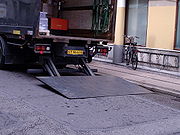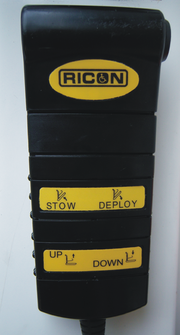
Tail lift
Encyclopedia



Van
A van is a kind of vehicle used for transporting goods or groups of people.In British English usage, it can be either specially designed or based on a saloon or sedan car, the latter type often including derivatives with open backs...
or lorry
Truck
A truck or lorry is a motor vehicle designed to transport cargo. Trucks vary greatly in size, power, and configuration, with the smallest being mechanically similar to an automobile...
, which is designed to facilitate the materials handling of goods from ground level or a loading dock to the level of the load bed of the vehicle, or vice versa.
The majority of tail lifts are hydraulic or pneumatic in operation, although they can be mechanical, and are controlled by an operator using an electric relay switch
Relay
A relay is an electrically operated switch. Many relays use an electromagnet to operate a switching mechanism mechanically, but other operating principles are also used. Relays are used where it is necessary to control a circuit by a low-power signal , or where several circuits must be controlled...
.
The use of a tail lift can obviate the need to use machinery such as a forklift truck
Forklift truck
A forklift is a powered industrial truck used to lift and transport materials. The modern forklift was developed in the 1920s by various companies including the transmission manufacturing company Clark and the hoist company Yale & Towne Manufacturing...
in order to load heavy items on to a vehicle, or can be used to bridge the difference in height between a loading dock and the vehicle load bed.
Tail lifts are available for many sizes of vehicle, from standard vans to articulated lorries, and standard models can lift anywhere up to 2500kg.
Column lifts
Column lifts are often mechanical, although they can be hydraulic or pneumatic. They run on 'tracks' fitted to the rear of the vehicle. From the tracks, a folding platform extends, which can be taken up and down.Column lifts have the advantage of being able to lift to a higher level than the load bed (and are therefore suitable for loads over more than one level in the truck. They are usually the easiest of the lift types to fit, as they require little structural work.
The disadvantages of column lifts include that the platform is only usually able to operate at a 90° angle from the track, meaning that on uneven surfaces, the lift will not meet the ground properly.
Cantilever lifts
The cantileverCantilever
A cantilever is a beam anchored at only one end. The beam carries the load to the support where it is resisted by moment and shear stress. Cantilever construction allows for overhanging structures without external bracing. Cantilevers can also be constructed with trusses or slabs.This is in...
lift is the type first developed by Zepro. They operate only on a hydraulic or pneumatic system. The system works by a set of rams attached to the chassis
Chassis
A chassis consists of an internal framework that supports a man-made object. It is analogous to an animal's skeleton. An example of a chassis is the underpart of a motor vehicle, consisting of the frame with the wheels and machinery.- Vehicles :In the case of vehicles, the term chassis means the...
of the vehicle. These rams are on hinges, allowing them to move angle as they expand or contract. By using the rams in sequence, the working platform can either be tilted, or raised and lowered.
Cantilever lifts have the advantage of being able to tilt, which means they can often form a ramp arrangement, which may be more appropriate for some applications. It also means that it can be easier to load or unload on uneven ground.
On tuckaway lifts, the ramp can be folded away under the load bed of the vehicle, leaving the option of it not being used when at a loading ramp, and giving access and egress for operatives without the need to operate the lift.

